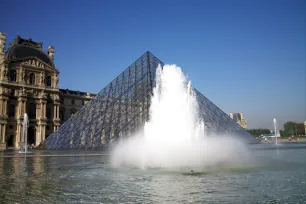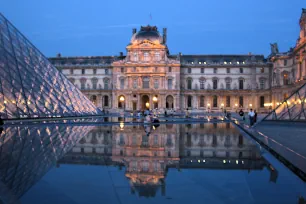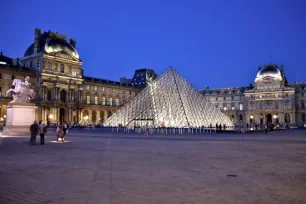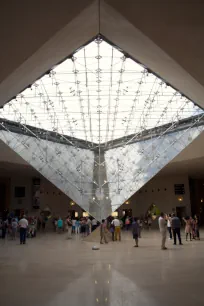The Louvre Pyramid was built in the 1980s as the main entrance to the Louvre Museum. The modern glass structure, which forms a nice contrast with the historic facades of the Louvre, has become a landmark in its own right.
Louvre Museum Expansion


The Louvre Pyramid was built as part of a project known as the ‘Grand Louvre’, first proposed in 1981 by the French president François Mitterrand, to expand and modernize the Louvre Museum.
In the 1970s, the centuries-old Louvre Palace struggled to cope with the rising number of visitors. The entrances were too small, each wing had a different entrance, and the layout was so confusing that visitors struggled to find the entrance or the exit.
Mitterrand suggested expanding the museum by relocating the Ministry of Finance – which had occupied the Richelieu wing of the Louvre since 1873 – to the Bercy neighborhood. Finally, the Louvre Museum could occupy the whole U-shaped building.

Subterranean entrance
Miterrand rejected the idea of a competition for the Grand Louvre project, and appointed the Chinese-born American architect Ieoh Ming Pei to modernize the Louvre and integrate the different wings. Pei suggested excavating the Cour Napoléon – a central courtyard – and create a subterranean entrance hall – the Hall Napoléon – with access to the three different wings and space for shops, restaurants and other amenities. This would solve the accessibility problem of the Louvre Museum.
The Pyramid
Geometric Shape

For the entrance to the subterranean level, Pei wanted to avoid it looking like a mere subway station, and he needed the right kind of building to draw visitors to the museum’s entrance. A solid concrete structure – like his East Building of the National Gallery of Art in Washington, DC – was out of the question, since this would clash with the classical facades of the Louvre palace.
After studying the works of André Le Nôtre – France’s great landscape designer – who strictly followed geometric patterns, Pei came up with the shape of a pyramid, which would form a beacon at the center of the courtyard. He opted for a glass cladding since this would be the least intrusive, and it would also allow light to enter the foyer below.
A Hostile Reception



As soon as word leaked that a modern pyramid would be built at the heart of the Louvre, most critics were quick to attack the audacious design. The plans also caused an outcry with Parisians, who had become weary of modern projects after the construction of the Montparnasse Tower and the bland towers of La Défense. Polls indicated a large majority of the French citizens opposed the structure. But soon after the official inauguration of the pyramid in March 1989, the opposition quickly subsided and the Louvre Pyramid became one of Paris’s most beloved modern landmarks.
The Design
The pyramid is rather modest in size compared to the surrounding palace wings of the Louvre. It has a height of about 22 meters (72ft) and at its base measures just over 35 meters (116ft). It is flanked by three smaller pyramids and reflecting pools with modern fountains.
Much effort was made to make the pyramid as transparent as possible. The 675 diamond-shaped and 118 triangular panes were specifically fabricated to make them completely clear. Attention was also paid to the 128 steel girders and 16 steel cables that hold the panes together. Technology from high-tech yachts was used to make them as small and unobtrusive as possible.

The Inverted Pyramid
In 1993 the underground area expanded with the opening of a modern shopping mall, the Carrousel du Louvre. It is anchored by an inverted glass pyramid, known as the Pyramide Inversée (Inverted Pyramid), which nicely complements the Louvre Pyramid.
The pyramid was designed by the American architecture firm of Pei Cobb Freed & Partners, who created a smaller version of Pei’s pyramid, turned it upside down right and suspended it right above a small stone pyramid.

